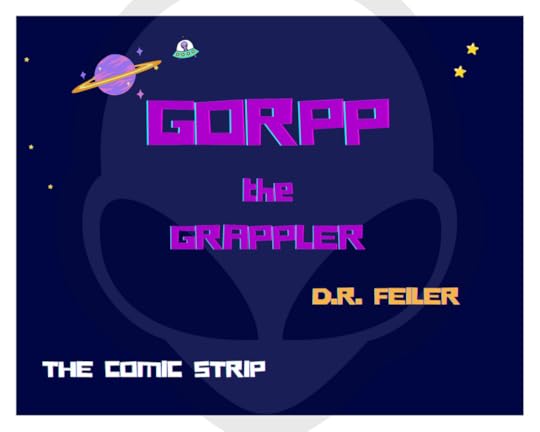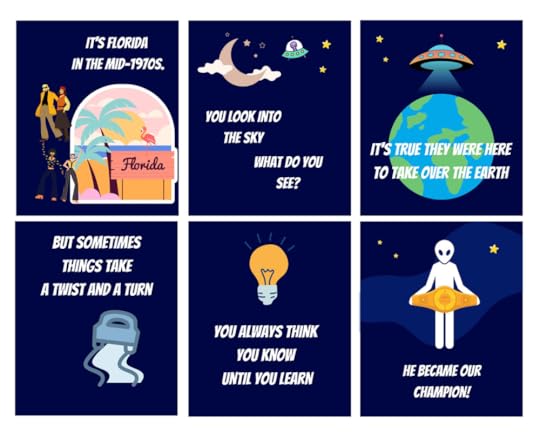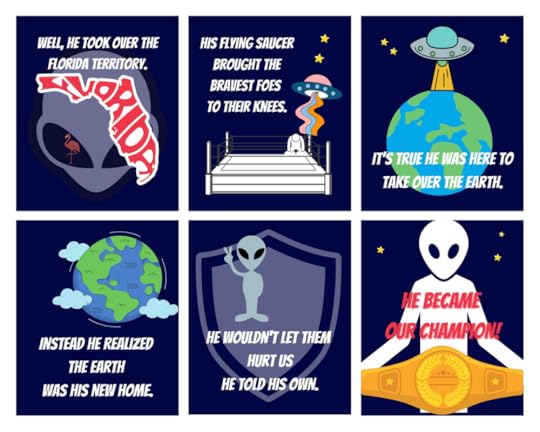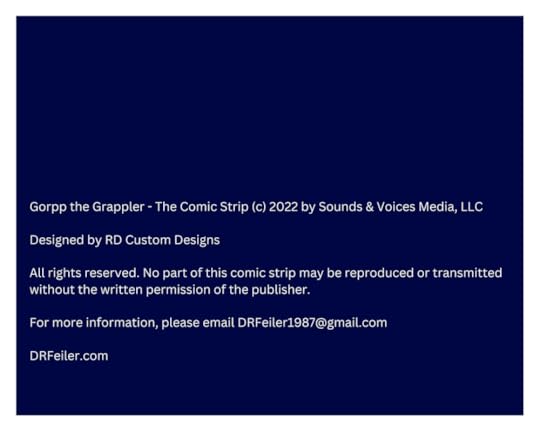D.R. Feiler's Blog
September 2, 2024
Fistic Love Affair
By D.R.Feiler
My first memory of boxing is a party at my parents’ house, possibly even before they separated. I would have been about four-years-old. The year, 1974. I’m sure the fight wasn’t the reason for the gathering but my memory is that a handful of people were gathered on the front porch, watching Muhammad Ali on a small black-and-white television. If I’m right that it was 1974, it was almost certainly either Ali’s win over Joe Frazier in New York on January 28th or his rope-a-dope “Rumble in the Jungle” win over Big George Foreman in Zaire on October 30th where nearly sixty thousand Africans chanted “Ali, bomaye!” (“Ali, kill him!”).
I don’t remember much about the fight – I was four – but I’m sure Ali won based on the mood of my parents’ inebriated friends after the fight. These north Florida hippies were Ali partisans with almost as much fervor as their counterparts in Zaire. Ali, bomaye! In fact, what I remember most is the reverence my parents’ friends had for Ali. And these were not boxing fans, not a sports crowd at all. No Seminoles caps or tailgaters in this crowd of homebrewers. But they just had so much respect for Muhammad Ali. It stuck with me. Later, when I could understand it, I learned why they felt that way about him and I came to share their admiration for Ali, as a boxer, and as a person willing to pay a terrible price for his convictions and his humanity.
As a kid, I created a whole imaginary boxing council consisting of my family members and pets as everyone from the profane boxing commissioner (my mom) to the charismatic champion of the world (me, of course). We had records and stats and colorful trunks. Over the years, the pictures turned into articles chronicling contests, some fictional, some born from some seed of truth, or supposed documentation. One day I’ll compile it all.

Left to right: me (the heavyweight champ), my dad, my mom and our dog, Thunder, all heavyweight contenders.
The next boxer I remember being aware of was Sugar Ray Leonard. There was a poster of him from the 1976 Olympics in my elementary school library, but it was Leonard’s fight against Thomas “Hit Man” Hearns when Sugar Ray fought through the pain and that big swollen eye on his boyish, movie star face, that cemented what has become a lifelong love of boxing. That was on September 16, 1981. Two days before my eleventh birthday. I remember watching that fight, as I would many after that, with my dad, in his funky little two-room place on Thomasville Road in Tallahassee’s midtown, though we didn’t call it that back then.
My dad never boxed, but he came from a hard upraising in the Bronx that involved frequent physical confrontations with his father, kids on the street and, later, in reformatory school. He carried himself with a determined resolve that short-circuited the need for most actual confrontations. He enrolled me in Tae Kwon Do classes at six-years-old and stayed on me to be disciplined about it until I got my black belt at age twelve. He used to make me spar with him. I don’t have particularly fond memories of that.
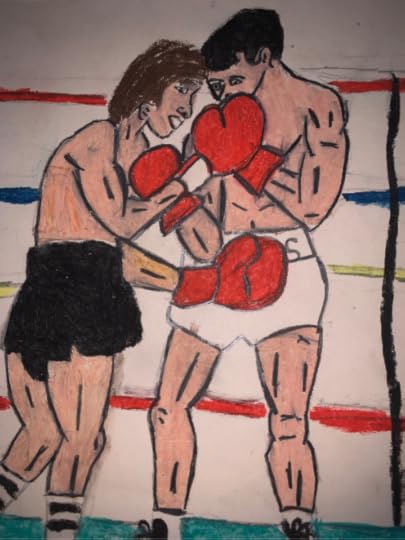
My drawing of the Argüello vs. Mancini fight, at age 11.
I do have fond memories of us watching boxing together. I remember seeing Ray “Boom Boom” Mancini lose for the first time to lightweight champion Alexis Argüello in a 14th round TKO. Like many people, I was a Mancini fan, but I had to admire Argüello. I remember the tragic death of Duk-Koo Kim after his 1982 bout with Mancini really impacting me. And there was this one Roberto Duran fight that he lost by decision. He railed about how unfair he thought it was but his interpreter was clearly sanitizing what Duran really said. It had my dad and I cracking up. But no fight from that eighties era looms larger in my memory than the “great white hope” Gerry Cooney’s valiant effort to take Larry Holmes’ world heavyweight title. My dad and I watched a lot of Larry Holmes fights over the years. As much as I looked up to Ali, Larry Holmes was really my generation’s heavyweight champ. And as much as much of white America may have been rooting for Cooney, my dad and I were cheering for the champ, Larry Holmes, who never really got the respect he deserved having to follow in the great Ali’s footsteps.
I had a few remarkable close encounters with the sweet science in the nineties.
Twenty years after the “Rumble in the Jungle,” the November 5, 1994 contest between George Foreman and Michael Moorer was billed “One for the Ages.” And it was the night Foreman made history, reclaiming the world heavyweight title at age 45. I entered HBO’s In the Hero’s Corner Sweepstakes and, as a first prize winner, got a pair of Everlast boxing gloves signed by Big George that are displayed in my office to this day.

Living in San Francisco, my dad got to know the son of award-winning San Francisco Examiner sports writer, Eddie Muller, who referred to himself as “the other Eddie Muller.” In 1997, it resulted in a really nice letter to me from “the other Eddie Muller” and he sent along a collection of what he called, “the old man’s flavor.”

Letter and collection of Eddie Muller articles in San Francisco Examiner
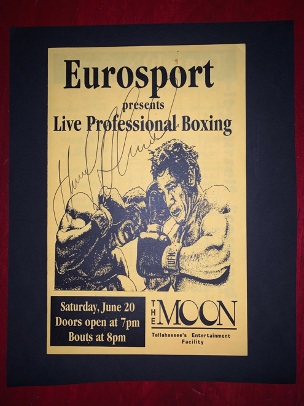
Signed program from Eurosport boxing card at The Moon.
There are cities with great boxing traditions, places like New York, Las Vegas, Detroit and Philadelphia. The places I’ve mostly lived, college towns like Tallahassee, Florida and Eugene, Oregon, are not among them. The only boxing card I ever saw live was at The Moon nightclub in Tallahassee. I think it was the summer of 2000. I’d never heard of any of the fighters. You wouldn’t have either though one of them was from Roy Jones Jr.’s stable which leads me to not only getting to meet but actually work with Florida’s own Roy Jones Jr., a former undisputed world champion considered by many to be one of the greatest pound for pound boxers of all time, and hailing from just down the road in Pensacola, Florida.
The PR firm I worked for in 2000 had a contract with the Florida Department of Transportation to do a seat belt safety campaign and somehow we got connected with Roy Jones Jr. I got to spend a day at his house/gym/recording studio and even check out his convertible Rolls Royce with the monogrammed leather seats. The script I wrote for the ad campaign “Buckle Up Before Impact” likened getting hit by a Roy Jones punch to a head on car crash.
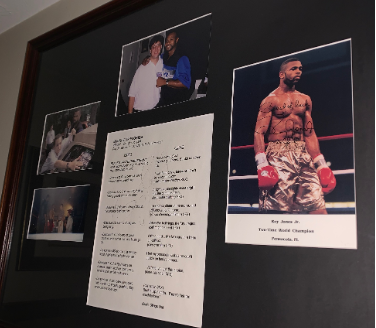
Left: the limo (top), making the ad (bottom). Middle: with Roy in his studio (top), my script (bottom).
Right: signed promotional picture
When I proposed to my wife in 2017, I wrote her a song called “Anything is Better Than Letting You Down” that listed all the terrible things I would rather do than ever let her down. One of the verses goes like this:
I’d rather be standing in line at the DMV
Or a cat trapped way high up in a tree
I’d rather fight Mike Tyson for all 12 rounds
Anything is better than letting you down
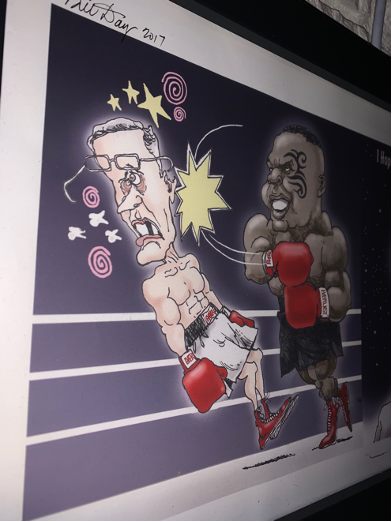
Illustration of me fighting Mike Tyson by award-winning cartoonist, Bill Day
I hadn’t kept up with boxing as much in recent years, until the pandemic, when archived fights on YouTube saved me during quarantine. I rewatched some of the great series like Barrera vs. Morales, Gatti vs. Ward and Bowe vs. Holyfield, especially the HBO broadcasts from the nineties. Best boxing productions and cards ever in my estimation. And that’s what led me to writing this book, as a kind of homage to those great broadcasts.
January 19, 2024
Do You Remember the Tallahassee Sports Stadium?
By Damien Filer
Note: this article originally appeared in Apalachee Magazine Issue 1 / December 2023. Apalachee is a publication of the Tallahassee Historical Society.

Graphic by Brendan Crellin for Tallahassee Historical Society's Apalachee Magazine Issue 1 / December 2023
Do you know what Andre the Giant (the “Eighth Wonder of the World”), The Doors (an iconic rock band), and the “Queen of Exotic Dancers” Tempest Storm (dubbed “the most controversial act in Tallahassee history”) all have in common?
You could have seen all of them in a nondescript warehouse on SW Capital Circle in Tallahassee in the 1970s.
Today, that warehouse is the home of MultiStone Custom Countertops. One of the reviews on its site says, “5 stars for the historic significance of this building...former Tallahassee Sports Stadium. Hosted many great wrestling events back in the 70s.” Indeed, for almost a decade that warehouse was home to the biggest names in professional wrestling anywhere in the world. This included legends such as Dusty Rhodes, Terry Funk, Jack Brisco, and so many more. Every Friday night, right here in little old Tallahassee. Can you imagine?
Those names were a big deal to me as a kid. The biggest. When I figured out that wrestling—like what I was seeing on TBS, The Superstation—was happening live, right up the road from my house, I started working on my mom to take me. One night, she did. Moreover, she was a photographer, so even though this was decades before we all had a smartphone camera in our pocket, I have pictures of those matches all these years later.
Lately I’ve been thinking about that night and that place. How rundown and dirty it felt. But when “The American Dream” Dusty Rhodes appeared in the flesh, dancing around the ring all bigger than life, I was swept into another world. We all were. At one point, an irate young fan charged the ring. The police intervened as Jack Brisco was helped from the stadium by his brother, Jerry. My mom and I followed them, the police, and a growing crowd outside. What a night.

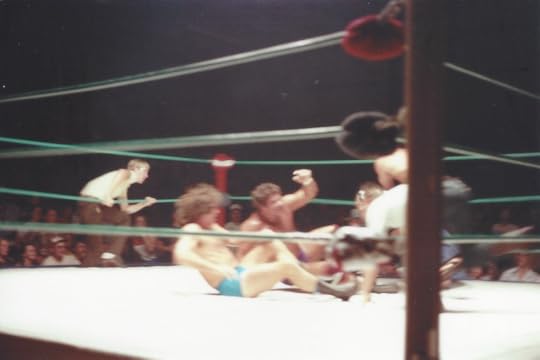
See the kid in the white shirt coming into the ring during the match between Jack Brisco and Don Muraco? I don’t remember and haven’t found a record of the match, but my theory, based on the pictures and the wrestlers’ reputations, is that Muraco wouldn’t release Brisco from a figure-four leglock, and that the wrestler in jeans is trying to free Brisco from the hold.

Law enforcement intervened in the ring.

Mom and I followed the procession outside.
That was a long time ago. I’m fifty-three now. I drifted away from wrestling in middle school when I discovered girls and guitars. And, to me, wrestling has never been the same since Vince McMahon admitted to the New Jersey State Senate in 1989 that it really was just entertainment, not an athletic contest. He committed what had been considered, for more than a century, to be the cardinal sin in wrestling. Back then, the industry went to great lengths to protect the secret of their contests being predetermined. Kayfabe. As a kid, I didn’t even think about it as being real or not real. It was extra-real, bigger, louder, cooler, better than real. Super-real!
There’s a time as a kid when you’re old enough to know that Santa Claus isn’t real. However, until that well-intentioned aunt, or less well-intentioned older kid, confirms it officially, you cling to the illusion that it is bigger and brighter than your “real” life. Whether it is the “American Dream” Dusty Rhodes or jolly old St. Nick, we want to believe. Don’t spoil it for us.
Looking back, I started to wonder just what was known or remembered about that old warehouse, located on what we then called the Truck Route. That warehouse hosted some of the greatest wrestlers from one of the all-time great eras of professional wrestling, and even iconic bands and other performers who passed through the Capital City.
I have to think The Doors playing there on March 11, 1972, was a pretty big deal. Jim Morrison had been an FSU student from 1962–64 and allegedly exposed himself in Miami in 1969. In 2010, then-Governor (and Doors fan) Charlie Crist worked to have the Florida Clemency Board arrange a pardon for Morrison’s convictions stemming from these onstage antics in Miami back in the ‘60s. In 1972, tickets to see the Doors and Badfinger at the Sports Stadium went for $4.00 in advance, $5.00 at the door.
People have shared recollections—some of which can be corroborated, others not—that they saw the Allman Brothers with Dr. John, Black Oak Arkansas, and Don McClean at the stadium. Curiously, I can find no record of Lynyrd Skynyrd, the other big Jacksonville band of the 70s, ever passing this way. A Tallahassee Democrat article from September 22, 1974, offers a review of a Sly and the Family Stone show at the Sports Stadium. One person recollects the terrible acoustics in what they describe as “an oversized pole barn with metal walls” when they saw the show in ’78 or ‘79. Another even remembers seeing “No Show” George Jones there. Others recall B.B. King, Marshall Tucker Band, and Ronnie Milsap.
The Florida Division of Corporations only shows records for the building for 1977 and 1979. But according to Florida Parcels, the Tallahassee Sports Stadium was built in 1971. It was owned by wrestler, promoter, and Tampa resident Eddie Graham (legal name, Edward Gossett) with lawyers Lester Welch and Thomas Smith from 1972–80. This jibes with the Division of Corporations’ list of registered agents for the 1977 and 1979 filings. The dates also coincide with the advertisements for wrestling and other shows in the warehouse. ClustrMaps says March 14, 1972, is the date the place was established and that it operated for eight years and four months. Interestingly, that date of operation is three days after the Doors show as advertised in the Florida Flambeau.
Eddie Graham and his son Mike were legendary Florida promoters and wrestlers. Tragically, several members of the Graham family committed suicide, including Eddie, his father, his son Mike, and grandson Stephen. Dusty Rhodes inducted Eddie Graham into the WWE Hall of Fame in 2008.
Thomas Smith, another of the owners, was an attorney who had graduated from Harvard Law School and served as a naval officer. He represented Championship Wrestling from Florida. He was a pilot and, according to his obituary, saved the passengers onboard a plane that crashed. He was also a Harley (Harley-Davidson, not Harley Race) enthusiast.
Like at the Doors show, ringside seats for these legendary wrestling cards were going for five dollars or less at the Sports Stadium in the ‘70s. Today, a poster advertising the matches at the Tallahassee Sports Stadium is listed for $750 on JO Sports, Inc., a retail company that sells boxing memorabilia.
People remember Dusty Rhodes making appearances all over Tallahassee. Accounts include him partying at The Electric Eye after the matches, and buying a Rolex at a local jewelry store (and “pretty things” for the ladies accompanying him). He also dined at Morrison’s Cafeteria and shopped at Capital Records and Tapes. Dusty, Andre, and Ric Flair all were sighted at Tallahassee’s landmark Brown Derby restaurant. And another story has Dusty and Harley Race eating breakfast at Frisch’s Big Boy on West Tennessee Street.
Kenny Ayers, whom I encountered on Facebook, shared the following story with me.
“Me and my buddies walked into the Brown Derby, as usual, and someone said Andre the Giant was in the restaurant. He was our hero back then. We saw the match, but couldn’t believe we actually [were] seeing him in that scenario. We walked in, he was by himself [at] a huge corner table eating his salad, which was an entire bowl that they kept at the salad bar. He was so massive. We just stared for a minute and then started talking to him. The nicest guy in the world. We didn’t want to wear out our welcome, so we went back to the bar. I talked to the waitresses later, and they said he ate two of those salads and four of their 32–oz “Great Steaks." And an awful lot of liquor...No pictures back then. Didn’t have today’s technology. Ha...A really great experience...that’s all I know.”
One person remembers their father being a regular at the matches. Drunk on Wild Turkey, he caused accidents in the dirt lot of the Sports Stadium, and even stabbed a wrestler in the calf who he was mad at for cheating. That’s how seriously fans took wrestling in the days of kayfabe. A lot of people also remember fondly the large cups of 75-cent draft beer and boiled peanuts outside.
A post on WrestlingMemories.com from someone who went to wrestling matches at the Stadium described it as a Butler building with chairs around the ring and wooden bleachers. He remembered that the bleachers appeared to be segregated. You can see evidence of that in my mom’s photos. I don’t remember whether I noticed it as a kid. I’m sure she did.
Longtime Tallahassee residents will remember Centennial Field, where Cascades Park is now located. It was constructed in 1924 and operational until 1975. Centennial Field was a Tallahassee institution that hosted the first Florida State football games, an exhibition baseball game between the minor-league Tallahassee Capitals and the New York Yankees, political rallies, and, of course, professional wrestling.
The Tallahassee Sports Stadium, operational from 1972–80, served as a kind of stopgap between Centennial Field that closed in ’75 and the Tallahassee-Leon County Civic Center that broke ground in 1978 and opened September 14, 1981. There are references to people calling the Sports Stadium the “old Civic Center.”
Tired of hunting and pecking in obscure corners of the internet for clues about this forgotten piece of Tallahassee history, I decided one night to get in my car and just drive out there and see the building for myself for the first time in decades. My wife was kind enough to ride with me. Even knowing where it is, I drove by it the first time. It’s an unassuming building on a largely unchanged stretch of SW Capital Circle.
Then, on a Friday afternoon, I drove out there again while it was still open. The matches at the Sports Stadium were on Friday nights in the 1970s. I imagined I was driving back in time as I wound my way through rush hour traffic on that Friday afternoon. Tallahassee is built up so much more now than it was forty-plus years ago. But once I passed the airport, things started to look more and more like they did back then. I even saw a guy selling hot boiled peanuts by the side of the road just before I pulled into the still-dirt parking lot at 4721 SW Capital Circle.
I snapped a picture before I stepped inside that building for the first time in more than forty years. Doing my research for this article, I was told the ring was still standing in the building. And that the building was slated to be demolished for Capital Circle to be widened. I was told all kinds of things. Now that I was standing in the building, I was hoping for a tour, maybe some more information from the current owner. I got a friendly reception, but I was told the owner was away, and he would need to give his blessing for me to get a tour of the building.
It seems the ghosts are in my head more than they are trapped in the confines of that Butler building. But they’re there. Maybe there should be an historical marker in front of that old warehouse so people know what happened there.
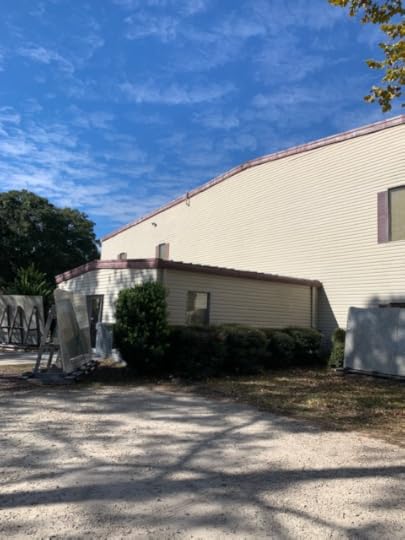
The old Tallahassee Sports Stadium as it looks today.
This isn’t the full story. I’m putting this out in the world in hopes of finding people who know more, have pictures, memories, anecdotes, or records to help fill in the missing pieces about this part of Tallahassee history. If you are one of those people, please email me at filerdamien@gmail.com.
Damien Filer is a Tallahassee native, author, and fan of the old territory days of professional wrestling. A fictionalized version of the Tallahassee Sports Stadium figures prominently in his new novel, Ambush at the Palace, written under the pen name D. R. Feiler.
January 13, 2024
Beau Jackson
by Damien Filer
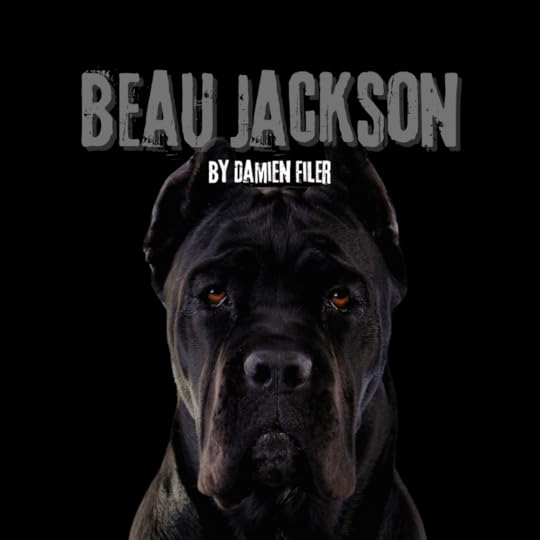
It was the week after Christmas and I’d recently learned a dog I adopted was likely an Australian Cattle Dog. So…that’s why he stares at me like that all the time. He gets very restless and needs to get his wiggles out. I try to walk him every day, usually just in the neighborhood, but I had some time off over the holidays so I made a commitment to take him to a different park or trail every day. We’d gone to the Fred George Greenway, a favorite for its open spaces and great trails as well as a personal connection to its origins.
We parked and started climbing the slope that leads into the greenway. It was a clear, cool December day, perfect for a walk. I had Odhi’s leash fully extended so he could rummage in the bushes along the trail. As soon as we crested the rise we had visibility over about a hundred yards of open field with paths leading off in different directions, some at gradual inclines or declines, others steeper.
Straight ahead, but a good ways away, I saw something emerge from cover. My first thought was, Bigfoot? As soon as we saw each other, it froze. When it did, I realized I was looking at a dog, a huge dog. I used to have a 185-pound English Mastiff and I felt confident that’s what I was seeing, some kind of Mastiff. But in a matter of a second, two tops, it bolted back in the direction it had come from and was gone from sight. It happened so fast, Odhi, my cattle dog, never even saw it. I just stood there for a minute, trying to make sense of what I’d seen. The huge dog definitely hadn’t been on a leash. Despite the signs, some don’t keep their dogs leashed. Maybe it just ran back to its owners. But that didn’t feel right. The dog looked scared, not like it was out for a fun walk. Maybe it lived in one of the neighborhoods that backed up to the greenway and it got out, or frequently explored the park. I didn’t know and, having my own dog with me, I couldn’t investigate, so I went the opposite direction, in hopes we wouldn’t cross paths with the beast.
It nagged at me though. Something didn't feel right. Why would a rare breed of dog like that be wandering around on its own in the middle of this public greenway? My daughter, Rowan, is twenty-seven and since she was a child she’s been committed – like the devoutly religious – to saving dogs. Since she was young enough to get an allowance she has worked, saved, researched how best to invest her donations, contributed to dog rescues, volunteered, rescued, fostered, nursed to health and all around devoted herself to saving the lives, and respecting the dignity and goodness of all canines (yes, and kids and cats and bunnies…but for many years dogs, as it was for my mom before me, and for me too). Dogs have always held a special place on all of our karmic scorecards.
Shortly after I started expressing my concerns about this dog to her she happened to be at the greenway, playing with her son and nephew, when she saw it. Like me when I had Odhi with me, with young kids with her she couldn’t try to approach the dog. No matter, because it took off when it saw them. They got a lot closer than I did though, and she said it didn’t look good. It had been out in the cold and the rain, with no food, for almost two weeks at that point. Rowan swung into action.
In no time, she found a listing on a city “lost pets” website for a blue-gray Cane Corso (an Italian Mastiff), that had gone missing on December 26. His name was Beau Jackson. I was raised with dogs, my first jobs were with dogs at veterinary hospitals and kennels and I’ve had a dog (or dogs) almost every day of my life. Only once before had I seen a Cane Corso. Apparently, the breed is experiencing a surge in popularity but they’re still uncommon. That was definitely the dog I’d seen.
I don't necessarily look for signs in things, but the fact that this creature had revealed itself, first to me, then to my daughter, I think imbued us somehow with a sense of obligation to help it, like it had chosen us to ask for help.
We started going out to the greenway with food, and a leash. When we went after dark we brought flashlights. We walked around the greenway calling his name, shaking a food canister. When he didn’t come, we would leave food for him, then check the next day and find it eaten, by someone. Rowan put up signs with her cell number. Our little search parties went out in shifts. But we never saw him again after the one time each of us caught a glimpse.
An unusually severe winter storm was forecast to come through the next night. He’d already been out there in the elements, with temperatures as low as the thirties, and no food for that big body for weeks now. Given how he looked when my daughter saw him, we didn’t want to imagine him out in that storm, with tornadoes in the forecast. She took her son out to the greenway after school and did a sweep. And they found something interesting. Someone else was leaving food out for him too. We weren’t alone. That was a meaningful morale boost when we really needed it. We also noticed not much of the food had been eaten. Something had checked it out but had left most of it there.
As dusk settled, the wind started picking up, and bands of rain moved into the area. After a nice warm dinner of stew and grilled cheese with my family around me, instead of snuggling in on the couch to watch our show as usual, I got dressed, put on a heavy jacket, grabbed the good flashlight, the canister of dog food, a plate and a leash, and drove out to the greenway. Rowan, of course, insisted on meeting me there, even though she had loaded up her family and dogs to ride out the storm at my house. Her family waited in the car while we set off into the night, calling out, “Beau! Come on and get your dinner, boy!” and “Come on, Beau Jackson. Come on!”
Rattling the canister of kibble, we walked up the hill to the plateau and trained our flashlights on the farthest edges of the woods we could make out through the fog and rain. We called again. Then I walked my daughter back to her car so she could get her family safely to my house. I went out for another round on my own. The rain was picking up. I kept calling, almost pleading for him to come. I started to wonder how much it was for him I was out here and how much it was now for me. I didn’t think I’d be able to sleep with him out in that storm, hungry and cold.
After another failed pass, I headed back to my car, trying to think of what else I could try. When my phone rang, it startled me. I couldn’t hear it that well in my pocket, in the rain. I swapped the flashlight to my other hand and dug the phone out of my jeans.
“Hello.”
“He’s home!” It was my daughter.
“What?”
“He’s home! I just got the message.”
I hadn’t allowed myself the indulgence of hoping he would be saved, only fuel for the determination to try to save him. It was such an instant weight lifted off me as I stood there in the rain, knowing, when I went home, that he wouldn’t be out in those woods tonight. I took a deep breath, put the phone back in my pocket and made my way back to the car, grateful to have no reason to serve Beau Jackson another dinner in the dark.
Dedicated to my daughter Rowan, a tireless servant, and frequent savior, of canines great and small.

July 2, 2023
My High School Band
by Damien Filer
Thought I'd crosspost this article I wrote for Tallahassee Punk in 2020 about my first band...
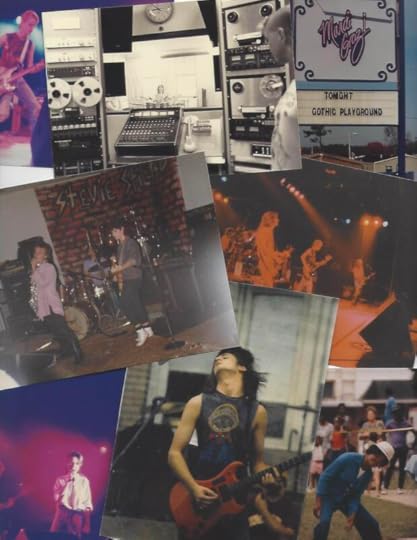
June 25, 2023
Is there really no such thing as bad press?
By Damien Filer
They say, “there’s no such thing as bad press.” They also say when Howard Stern was on the radio in New York the people who hated him listened for longer than his fans. But if I’m being honest, it still probably took the remove of time to allow me to laugh when I found out Analog Science Fiction and Fact magazine reviewed my short story collection, From Blood to Water, and concluded it should be set ablaze. That’s pretty harsh. Don’t you think? Even unsettling amid the new fervor to ban books. Here’s my best attempt to reconstruct the story twenty-four years later.
In 1998, I saw myself as an up and coming writer. I was a grant recipient of the California Institute for Contemporary Arts and they decided to release a collection of my short stories in a way that was, in 1998, pretty cutting edge. The stories were to be read on a computer and had accompanying artwork and a soundtrack throughout. A new immersive way to read. More like a movie.
The institute that published From Blood to Water even hired a PR agent to promote it. I remember meeting her at a fantasy convention in South Florida to talk strategy. She struck me as well intentioned but she didn’t really know her way around the publishing world, or more specifically, the genre world (sci fi, fantasy, horror etc…). My stories ranged from mainstream to slipstream to straight out science fiction.
I’m sure she sent out review copies to the big science fiction magazines like Asimov’s and The Magazine of Fantasy & Science Fiction. Analog was the other in the big three but it wouldn’t have occurred to me to send it there because their specialty was hard science fiction. My stories were far from it.
The reviews I got – the ones I knew about anyway – were good. Dark Planet called it “More literary than genre-bound…by turns sensual, touching, and disturbing.” Sci Fi Entertainment said it had “A touch of The Twilight Zone.” And Talebones said the stories ranged from “From good to excellent.”
Fast forward 24 years. It’s 2022. I’m getting ready to launch a new publishing company and this leads me down a rabbit hole on the internet where I discover, 24 years later, my short story collection was reviewed by Analog! I never knew. I couldn’t find the review online but old copies of the issue in which it appeared (June, 1999) were available for a few bucks on eBay. I ordered one.
Part of me was just curious but I’m also an archivist so now that I knew this review existed I needed a copy for my library, my brag shelf, so to speak. I’ll admit, I was also thinking maybe if it was really good I could use an excerpt from it on my website or on a book jacket. A week or so later the old copy of Analog arrived in the mail.
It wasn’t in mint condition (I’m a stickler) but at least I had it. I thumbed through and found the review section. Tom Easton’s “Reference Library” included ten book reviews and I was in with some heavy hitters. Walter Mosley. Ray Bradbury. My review was the last and shorter than all the rest. Much shorter.
It turns out he never even read the stories. I guess the CD-Rom not only wouldn’t play, it froze up his computer. His frustration was with the technology. Ironic, because it’s the only reason I can figure they decided to review my collection in the first place. Not for the stories. For the technology. And it failed.
Tom Easton apparently spent thirty years as a columnist for Analog. He’s also the only person I’ve ever heard of who had trouble with the CD-Rom. Too bad. I know it’s a little late but I think I’ll see if I can send him another copy. You know, in case he wants to actually read the stories.
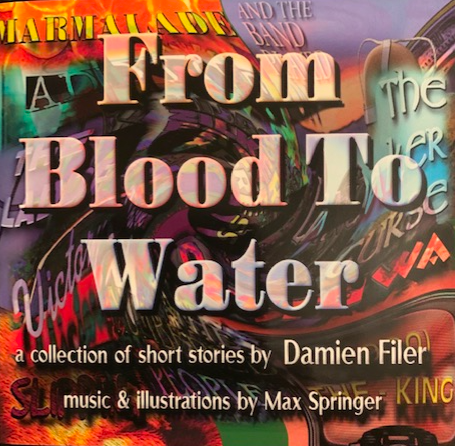
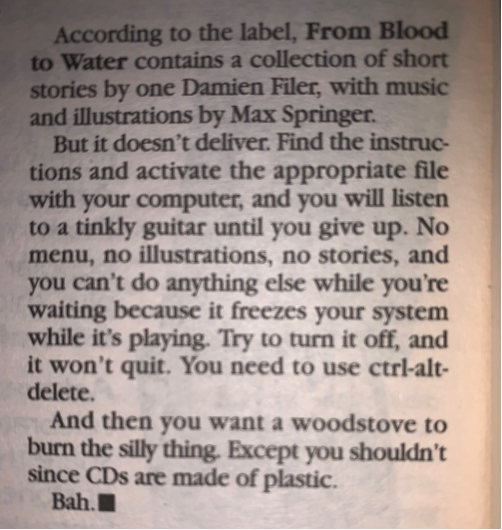
October 2, 2022
September 11, 2022
Back to the Future of Workshops Past
By Damien Filer
The Ghost of Workshops Past: How Communism, Conservatism, and the Cold War Still Mold Our Paths Into SFF Writing didn’t exactly sound like light reading after a long day’s work. And it’s long. But I read it because I was intrigued by what Damien Walter posted in response to it. He also made it clear the article largely dealt with the Clarion Writer’s Workshop and I’m a graduate. Class of ‘95.
S.L. Huang, the article’s author, makes a well-researched and well-reasoned argument against the Milford style of fiction workshop Clarion is modeled on.
As an adjunct at a state university myself, I agree wholeheartedly with the article’s conclusion, that we must endeavor to keep evolving and exploring different approaches to teaching in an effort to respect, hear and support as wide a range of different life experiences and perspectives as possible.
My impression from the article is that Huang did not attend Clarion but has clearly researched it and other workshops extensively. The responses I’ll share below represent my lived experience twenty-seven years ago with a unique makeup of staff, instructors and students. And all I can say is that my experience with many people I knew was very different from what the article describes.
I traveled cross country from Florida to the west coast as a younger man, in the early ‘90s and settled for several years in Eugene, Oregon. I was awarded a grant by the California Institute for Contemporary Arts shortly after arriving there that allowed me to quit my minimum wage bookstore job and write full time for a year. I took the opportunity seriously and treated it like a literary, if not literal, bootcamp, writing hundreds of articles, reviews, poems and stories in that time, looking for any opportunity to get into print. And I explored the resources available to me in my new home in Eugene. Little did I know I’d stumbled into one of the most thriving and supportive writing communities in the country.
I found my way to the Eugene Professional Writers Workshop's (later to become Wordos) weekly, Milford-style, workshop in the back room at G Willikers restaurant on Tuesday nights. The room bustled with dozens of unassuming but accomplished writers. And, while they were a friendly enough group, there was definitely a sink or swim air to the proceedings. You had to show you deserved to be there. The style of critique depended on the person but most folks weren’t pulling any punches. I learned the difference between infer and imply by using one when I meant the other in that workshop. It’s not a mistake I’ve made again in the ensuing quarter century, I can tell you that.
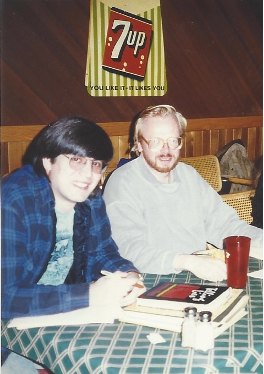
At the Eugene workshop, mid-90s, with Stephen Stanley, who would go on to be the first person
to win the Writers of the Future and Illustrators of the Future contests.
I very much subscribe to the values of kindness, courtesy and respect but I do believe we do a disservice to a student by offering false encouragement or praise. Constructive critiques can be done without cruelty.
I learned about Clarion from the Eugene workshop. I applied and it was a big deal (to me, anyway) when I got accepted. Huang’s article talks about what it means to become part of the select group that have attended Clarion. For me, as a young writer of 24, worried that my mother-in-law thought I was sitting around all day doing nothing, it was validating. Something credible I could point to other than the poems I was getting published in coffee house zines.
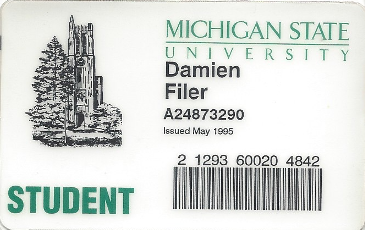
There are some specific things I want to respond to in Huang’s article, starting with the cost to attend Clarion. I had no resources or savings so I applied for a scholarship through Clarion to help offset the cost of attending. I still have the certificate Clarion’s director, Tess Tavormina, presented me with out in front of a local bookstore in Lansing where one of our instructors was giving a reading. I was one of several students that year to be awarded the 1995 Friends of Clarion Scholarship. I couldn’t have attended without it and to this day I'm grateful to the contributors who made those scholarships possible. Again, I think Huang makes a valid point about cost being a barrier to entry for many writers, and I don’t know what scholarships, if any, were, or are available to other classes. I just know it made the difference between going and not going for me.
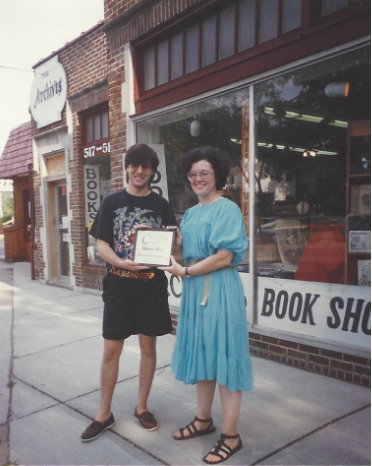
The article also implies (not infers) that Clarion grads have some sort of advantage by being able to move through the industry together. I definitely experienced that connection you hear about when you’re in the proverbial foxhole with people. A number of us got pretty close while we were there. But we really didn't stay in touch for long once we all got back to our lives. As someone who mostly stepped away from fiction publishing for a few (25) years, I’ve just recently had some joyful reunions with old Clarion classmates but I don’t remember any sense of us being a cohesive unit of some kind after we graduated from the workshop.
One of the central points of the article, dealing with the problematic aspects of the Milford approach for BIPOC and other marginalized communities, is one I can only address from my own perspective as a straight white male. It was disheartening for me to read some of the condemnations of the Milford approach in the article. They have made me rethink my own experience and wonder if I was oblivious of issues my classmates may have experienced. At times, this article felt like the missing writer’s workshop chapter in Dr. Robin Diangelo’s White Fragility: Why It’s So Hard for White People to Talk About Racism, which I would recommend.
I also had the good fortune to be invited in by Damon Knight and Kate Wilhelm after Clarion. I spent time at their home, ate at a Chinese buffet with them once a month and had quite a few of my stories workshopped and critiqued by them. All I can say is that I only ever found both of them to be supportive and kind to me as a young whippersnapper and I’ll be forever grateful to them for that.
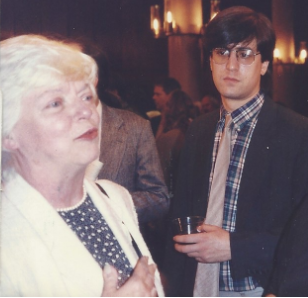
With Kate Wilhelm at the Oregon Book Awards (if memory serves)…check out my plaid shirt!
Huang also addresses the question of what, if any, advantage the Clarion pedigree gives to up and coming authors. I certainly included it in my cover letters. I think the workshop has a strong reputation in the industry but I don’t feel I can point to any real evidence that it made a difference when it came to selling stories. Maybe editors would pick a Clarion grad’s story out of the slush pile to read (I don’t know) but they weren’t going to buy a story they didn't like from a Clarion graduate, at least not this one.
That being said, for me, it was a great experience for a variety of reasons, starting with that sense of validation it gave me just getting accepted. I learned a lot there. I wrote a lot there. I made meaningful connections with smart, well-meaning people with similar interests. And I came home with a Michigan State t-shirt and some great stories to tell.
While the Milford style of workshopping at Clarion does operate more like a courtroom than a cable news show, the notion suggested in the article that if you speak up, you’re a “bad writer” didn’t jibe with my experience either. While we adhered to a certain protocol during critiques, there was a constant exchange of ideas happening all our waking hours, from meals together to card games in the dorm’s common room to late night conversations, readings and other gatherings. And the idea of molding one’s writing to conform to a workshop norm or standard was also alien to me. With instructors from Samuel R. Delany to Joe Haldeman to Karen Joy Fowler and students from Kelly Link to Nalo Hopkinson to Lucy Snyder, there was a wealth of diverse viewpoints, lived experiences and approaches to the craft of writing.
I would just say that my lived experience, with Clarion and its founders, contrasts with the negative light I felt they were cast in in this telling. And I didn’t really understand who the bogeyman was in this story, who is so resistant to change. It seemed to me that, when approached by the article’s author, the people from Clarion and other writing workshops all said they were making changes to address the concerns with the lack of alternatives to the Milford approach.
Any piece of writing that grabs me by the collar and makes me read it, then has me thinking about it and talking about it, even writing about it, that's good writing. S.L. Huang, thank you for doing that with this piece. I look forward to checking out more of your work. I thank you, as well, for the education and back story I didn't know about something that played a significant role in my writing life.
As I mentioned, while I’ve continued to write in a variety of settings, I did largely step away from fiction writing for the most part for more than twenty-five years. I did so because I had a family and I needed to make more money than I was making writing. But, in the interest of being as openminded as possible, and being as intellectually honest as I can, I will note this: I wrote a new science fiction novel last summer and got in touch with some old writer friends to get caught up on the state of the industry as I considered how to go about getting the book published. I had to have a writer from the old Eugene workshop assure me that I didn’t need to get my book workshopped or critiqued, that I knew what I was doing and the story I wanted to tell and I told it. He was kind enough to proof it for me and caught a few typos. That was it. I realized I had been, for better or worse, trained to think I couldn't put something out there in the world until I’d put it through the workshop gauntlet. The idea that I didn't have to do that was an epiphany to me. This, despite having come from a very DIY ethos as a musician in the punk movement in the eighties where doing everything ourselves was a matter of principle. It would never occur to me to need anyone’s blessing or critique of a song I wrote.
I say all of that to point out that Huang is right; it behooves us to continually reimagine, experiment and reinvent how we learn and how we teach and support artists. But also that we, as writers, once we’ve learned the fundamentals, have to take some responsibility to get over it if people don’t like our stuff and figure out how to put our books in front of those who will.
August 28, 2022
The Forgotten Champion – A Profile of Tommy “Wildfire” Rich
By Damien Filer
Updated August 28, 2022
When I was a kid, growing up in North Florida, we only got one channel on our TV – the superstation, WTBS from Atlanta, Georgia. Gordon Solie anchored broadcasts of Georgia Championship Wrestling and, when I started watching in the late 1970s, featured some of the greatest names in all of wrestling history from Ric Flair to Dusty Rhodes, from Harley Race to the Funks and Brisco brothers. But one of the brightest stars from that era has faded as the history books have been written – Tommy “Wildfire” Rich.
The fact is that between 1973-84 only eight men wore the prestigious NWA world title belt known as the “ten pounds of gold.” But one of the eight, Tommy Rich, is seldom mentioned when the championship is discussed. Well, Tommy Rich has done enough for wrestling – or rasslin’ as Rich would call it – to be remembered as a champion.
Granted, Rich only held the title for a few short days back in 1981 but he electrified wrestling fans in his heyday, and his accomplishment — taking the title, if only briefly, from Harley Race — should be recognized. Even Harley Race has defended Rich as a legitimate champion. And, not surprisingly, Rich was named the most popular wrestler of 1981 in addition to being one of the youngest men ever to hold the title.
It’s telling that The Pictorial History of Wrestling, published in 1984, called him not only “one of the most skilled” and “dedicated” but also “one the most polite and considerate wrestlers ever to grace the ring.” Terry Funk called him Georgia Championship Wrestling’s “big star.” And in the early 1980s, there truly were few who shined brighter than “Wildfire.”
Tommy Rich was the southern man’s example of someone the girls wanted to be with and the guys wanted to be. He represented youth in an idealistic but also a realistic way. Rich had a temper and he wasn’t the smoothest talker but he clearly wore a white hat. He was someone a little boy could look up to. He was as good an example of a babyface as you are going to find. Here was a bleach blonde and handsome hero to provide an alternative to the bluster and ego of Ric Flair.
Tommy Rich started his storied wrestling career in his native Tennessee almost fifty years ago. Apparently, he proved his work ethic as a teenager on promoter Jerry Jarrett’s farm to earn his first shot wrestling. It only took him two years before he was headlining cards at the Mid-South coliseum where, in 1976, more than 8,000 fans packed in to watch him take Jerry Lawler’s NWA Southern Heavyweight Championship.
In addition to his meteoric rise in Georgia Championship Wrestling (that included capturing the world title one fateful night in Augusta, Georgia) Rich has held a myriad of other titles, worked in everything from regional to extreme promotions and been part of legendary tag teams and storylines, including a heel turn when he once, infamously, was quoted saying, “The fans can go to hell!” That sent shockwaves felt by young boys in living rooms across the country, not to mention quite a few of their sisters, mothers and grandmothers.
One of Rich’s best known and longest lasting feuds was with “Mad Dog” Buzz Sawyer. It finally concluded with the “Last Battle of Atlanta” in 1983 — a “last man standing” cage match. Rich and Sawyer eventually joined forces to take on the Road Warriors. Later, Rich lost a “loser leaves wrestling” match to Ted Dibiase and returned as the masked Mr. R.
Back in 2008, when asked why he didn’t use his star power to make the jump to the WWE (then WWF) back in the 80s, Rich said he considered it but in the end he just preferred the “old school” and felt more comfortable with the independent promotions. After Hulk Hogan came on the scene Rich never really saw the limelight again in quite the same way.
Tommy Rich used to enter the ring to Reo Speedwagon’s “Roll with the Changes” and that’s just what he’s done throughout his career. These days, the “Wildfire” is still burning bright. Rich still has a love and passion for old school rasslin’ that is needed now more than ever. And he still has his quick wit and sense of humor too.
In March of 2016, when Bill Apter asked Rich what he was up to these days, Rich responded, “about 240!” putting his hands to his midsection. Now, in his mid-sixties, Rich doesn’t look like a babyface anymore. In addition to the weight he wears the scars on his face of almost half a century in the squared circle…and perhaps some regret that after capturing the world title for five fateful days so early in his career he was never able to reach those heights again. But he and his fans will always remember that he did win the title, fair and square.
I’ve read the books about the other fateful eight who held the “ten pounds of gold” but where is the book about Tommy Rich? With all that has been written about wrestling to this point, the time has come to acknowledge the forgotten champion, Tommy Rich, and his place in history.
Prior version originally published at ProWrestling.com in 2017.

